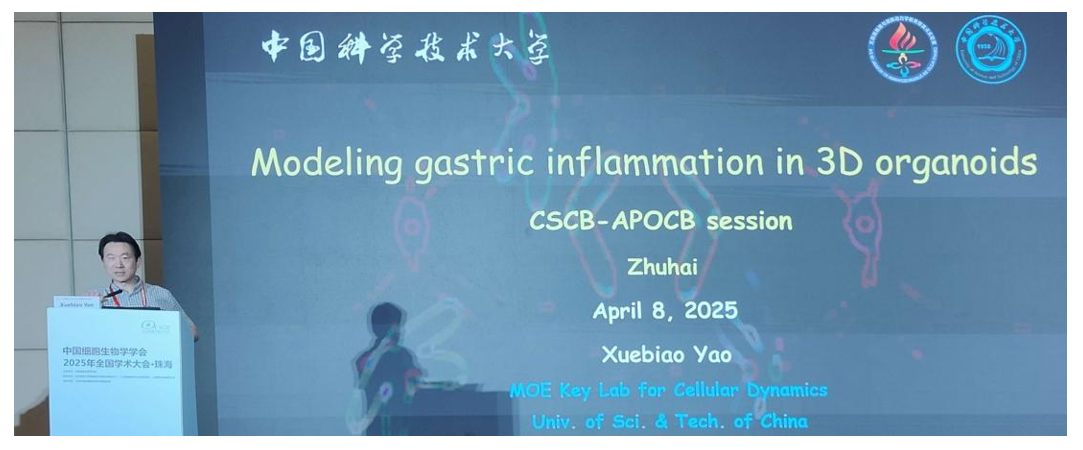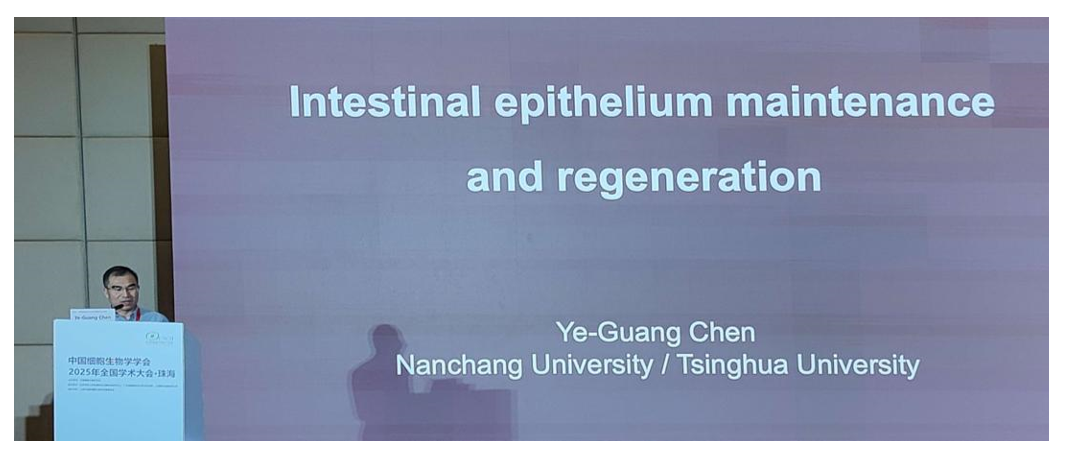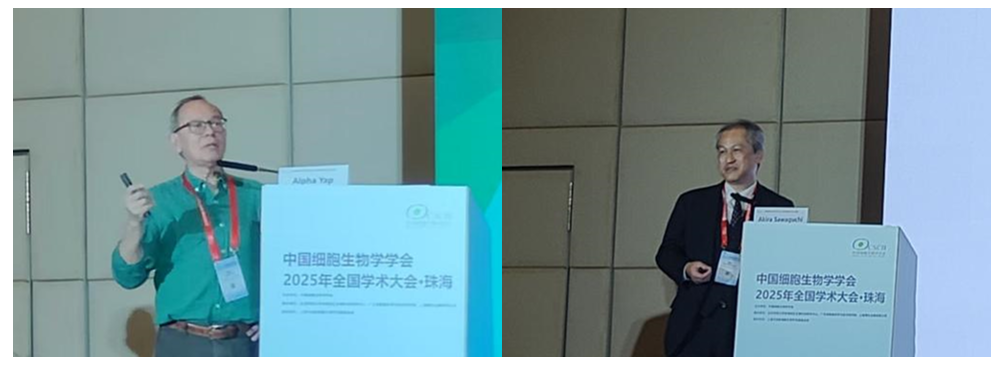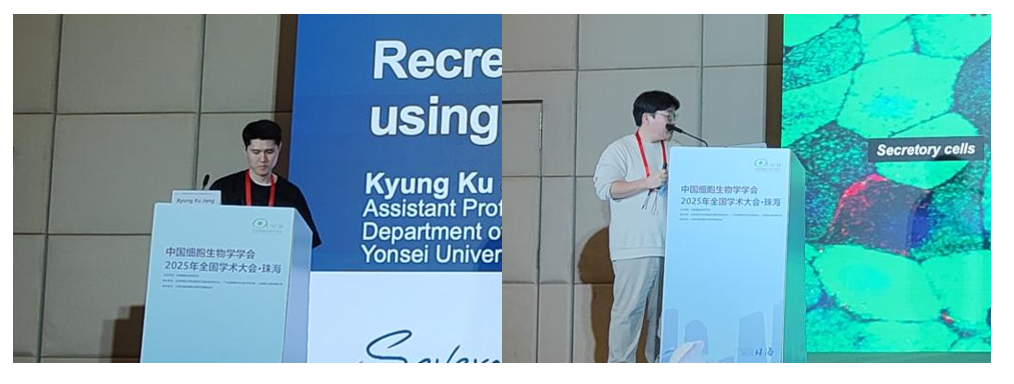


Under the leadership of Academician Ye-Guang Chen, President of the Asia-Pacific Organization for Cell Biology (APOCB), collaboration and exchange among APOCB member countries have been strengthened, promoting academic interactions and partnerships in cell biology research and among young scholars in the Asia-Pacific region. The Chinese Society for Cell Biology (CSCB) has established a new paradigm of "academic diplomacy" through its annual CSCB-APOCB joint sessions, enhancing the voice and influence of Asia-Pacific cell biology organizations in intercontinental exchanges and cooperation. During the 2025 National Academic Conference, the international forum co-initiated by APOCB President Ye-Guang Chen and CSCB Vice President Xuebiao Yao not only show cased cutting-edge breakthroughs in organoid technology but also highlighted the synergistic effects of CSCB’s leadership in fostering transnational scientific collaboration.
Held on the first day (April 8, 2025) of the Zhuhai Cell Biology Annual Conference, the "Organoid Construction and Cell Population Plasticity" international forum served as a vital platform for regional collaboration. The event attracted nearly 100 experts and scholars from China, Japan, Australia, South Korea, Singapore, and other countries, with young scholars accounting for 35% of the presenters—reflecting CSCB’s strategic focus on nurturing the next generation of scientists. In his opening address, Academician Ye-Guang Chen emphasized that organoid technology is at a critical transition phase from basic research to clinical application, requiring global collaboration to overcome challenges such as technical standardization and clinical validation.

Left: Group photo of joint session speakers
Right: Academician Ye-Guang Chen delivering the opening speech
Focusing on fundamental scientific questions in life sciences—cell communication and interaction—the team led by Professor Xuebiao Yao from the University of Science and Technology of China (USTC) presented a landmark 4D organoid model for gastritis. Targeting H. pylori, a major cause of gastric cancer, their study revealed for the first time the molecular mechanism by which the VacA virulence factor triggers pathological changes through disrupting apical membrane plasticity in gastric parietal cells. By precisely simulating the gastric mucosal microenvironment, this model enables full-cycle observation from bacterial infection to inflammatory cytokine release, offering a novel and efficient platform for targeted drug development.

Professor Xuebiao Yao from USTC delivering a report titled
"Modeling Gastric Inflammation in 3D Organoids"
Academician Ye-Guang Chen’s team at Nanchang University systematically presented frontier discoveries in intestinal homeostasis regulation. By integrating single-cell sequencing and organoid dynamic tracking technologies, their LGR5-labeled system successfully decoded the spatiotemporal regulation patterns of the Wnt/β-catenin signaling pathway. Their identification of the Bcl11b-mediated crosstalk mechanism between BMP and Wnt signaling pathways promotes intestinal epithelial regeneration, opening new therapeutic avenues for intestinal diseases.

Academician Ye-Guang Chen from Nanchang University delivering a report titled
"Intestinal Epithelium Maintenance and Regeneration"
The international collaborative innovation spirit of this forum was exemplified in presentations by scholars worldwide:
Professor Alpha Yap from the University of Queensland, Australia, utilized super-resolution imaging to reveal a novel paradigm of mechanical force conduction in epithelial cells, demonstrating how locally damaged apoptotic cells are extruded from the apical membrane through ATP-dependent mechanical force conduction to maintain tissue homeostasis.
Professor Akira Sawaguchi from University of Miyazaki, Japan, developed a KMnO4/Pb thick-section staining technique combined with low-vacuum scanning electron microscopy, breaking through tissue imaging bottlenecks with broad biomedical applications.
Professor Jennifer Zenker from Monash University, Australia, employed super-resolution microscopy to elucidate the role of the non-centrosomal microtubule-associated protein CAMSAP3 and its interaction network in cell fate determination during early embryonic development, uncovering the molecular mechanism of asymmetric RNA inheritance from parental cell.
Assistant Professor Kyung Ku Jang from Yonsei University, South Korea, identified MATE1 as a key factor in inflammatory bowel disease treatment through organoid-based studies on tofacitinib drug response heterogeneity.
Assistant Professor Jinwook Choi from the Gwangju Institute of Science and Technology, South Korea, revealed that macrophage-secreted IL-1β drives alveolar epithelial cells reprogrammed from AT2 cells to AT1 cells during lung inflammation, reshaping the tissue microenvironment.



Highlights from speakers’ presentations
During the conference, scholars from various countries shared their work on "Organoid Construction and Cell Population Plasticity" and explored bilateral and regional collaborations, such as the "Belt and Road Organoid Workshop".


Engaging discussions among participants
In closing, Professor Xuebiao Yao, Vice President of CSCB and Secretary-General of APOCB, summarized this joint session. On behalf of the societies, he expressed gratitude to all speakers, organizers, and volunteers, emphasizing that this joint symposium significantly elevated the international visibility of Chinese cell biology research. He noted that this collaborative model-anchored in shared scientific challenges and platform resources-may redefine global research cooperation in the post-pandemic era, manifesting the leadership of CSCB in driving transnational scientific synergy.
© Copyright Asian-Pacific Organization for Cell Biology All rights reserved.